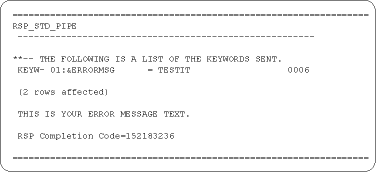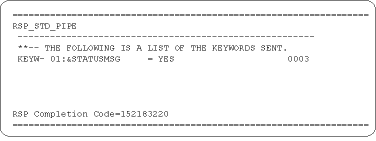The examples in this section demonstrate how the sample RSP suppresses the error code or the text of the error message.
The code in the following figure passes &ERRORMSG= to ERROR-CHECK.

The following figure contains the results that the client application receives:

The RSP code does not set
SPSTATUS='E'
and so does not pass a value through the SPRC field. As a result, the “DG21002: Result failed. Database server error code” message does not display an error code.
The code in the following figure passes &STATUSMSG= to STATUS-CHECK.

The following figure contains the results that the client application receives:
Figure D-6: STATUSMSG response

RSP4C’s paragraph 522-SEND-KEYWORD-HEADING on writes the following:
**-- THE FOLLOWING IS A LIST OF THE KEYWORDS SENT.
In RSP4C’s paragraph 524-READ-WRITE-KEYWORDS on, however, STATUS-CHECK sets the ERROR-HAPPENED switch.